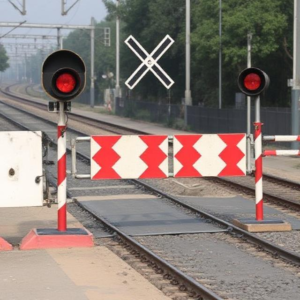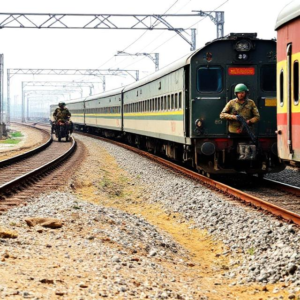Integrated Traffic and Rail Control is a system designed to improve the way both road and rail traffic are managed, especially in areas where they share the same space, like in shared transport corridors or near railway crossings. This helps reduce delays, prevent accidents, and make transportation safer and smoother for everyone.
Let’s break down the two key parts of this system:

1. Combined Road and Rail Traffic Management
What it is: In areas where trains and cars use the same route or cross each other, managing both road and rail traffic together is important. An Integrated Traffic and Rail Control System coordinates how both types of traffic move through shared spaces, like railway corridors, so that neither one is delayed or causes accidents.
How it works:
- Coordination Between Trains and Cars: This system keeps track of both road and rail traffic. It ensures that when a train is passing, the system can manage car traffic (like stopping or rerouting cars) to prevent a traffic jam or collision.
- Smoother Movement: It helps make sure that trains and vehicles don’t get stuck waiting for each other. For example, if a train is coming, the system can automatically clear the road or change traffic lights to allow the train to pass without delay.
- Reduced Congestion: With both road and rail traffic being managed together, the system can prevent bottlenecks and reduce congestion in areas where roads and railways overlap, especially in busy areas.
Why it’s important:
- Faster Travel: Vehicles and trains don’t get in each other’s way, leading to smoother and faster movement for both.
- Less Traffic Jam: By controlling when and where trains and cars move, the system can keep the roads clear and prevent long delays.
2. Railway Crossings Automation
What it is: A railway crossing is a place where a road meets a railway track. Sometimes, when a train is passing, cars or pedestrians need to wait for the train to go by before crossing the track. Railway Crossing Automation uses technology to automatically control the crossing gates and lights to make sure it’s safe for cars, trains, and pedestrians.
How it works:
- Automatic Control: The system uses sensors, cameras, or signals to detect when a train is approaching the crossing. When a train is nearby, it automatically lowers the crossing gates, turns on warning lights, and even sounds an alarm to warn vehicles and people that they need to stop and wait.
- Synchronization with Train Schedule: The system can also sync with the train’s schedule to know when it’s due to arrive. This means that the crossing gates can be lowered in advance, giving people and cars enough time to stop and wait for the train to pass.
- Prevents Accidents: By automating the crossing, the system makes sure that gates close at the right time, reducing the chances of an accident caused by someone crossing the tracks while a train is coming.
Why it’s important:
- Safety: Automating railway crossings makes them safer by ensuring gates are down and warning signals are active when a train is coming.
- No Human Error: Since the system is automated, there’s no risk of someone forgetting to lower the gates or misjudging when to stop, which can happen with manual operation.
- Faster Crossing Time: It reduces delays by ensuring that vehicles and pedestrians don’t have to wait longer than necessary for a train to pass.
In Summary:
- Combined Road and Rail Traffic Management helps coordinate trains and cars in areas where they share space, reducing delays and preventing accidents.
- Railway Crossings Automation automatically controls crossing gates and signals, ensuring that vehicles and people stop safely when a train is approaching, reducing the risk of accidents.
Both systems work together to make travel safer, smoother, and more efficient for everyone, whether you’re driving, walking, or riding a train!
Keywords: Railway Data Analytics, Railway











